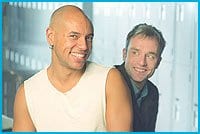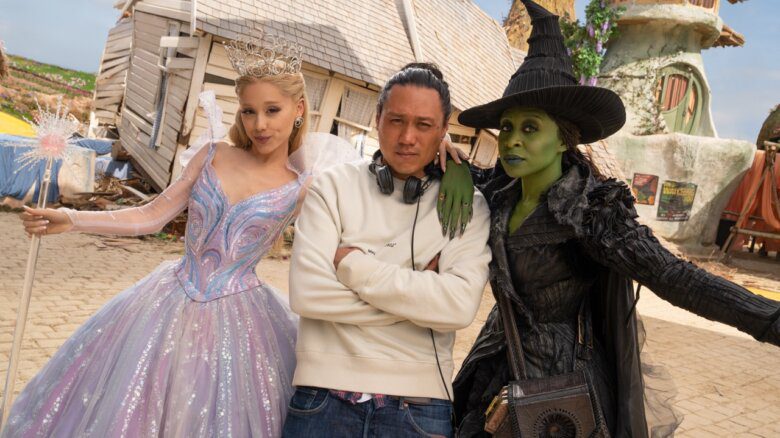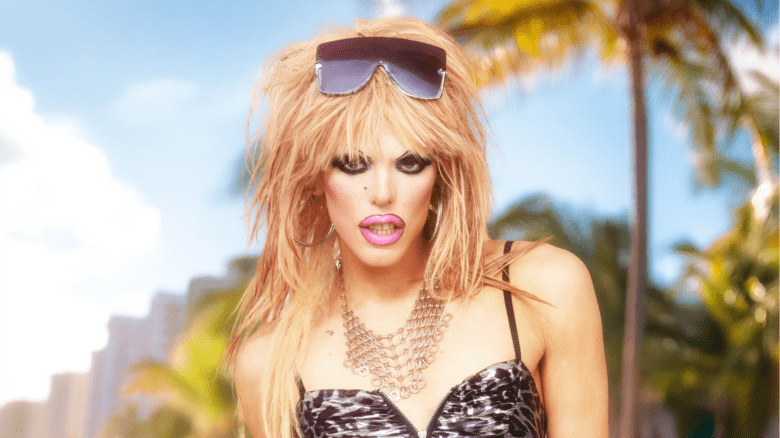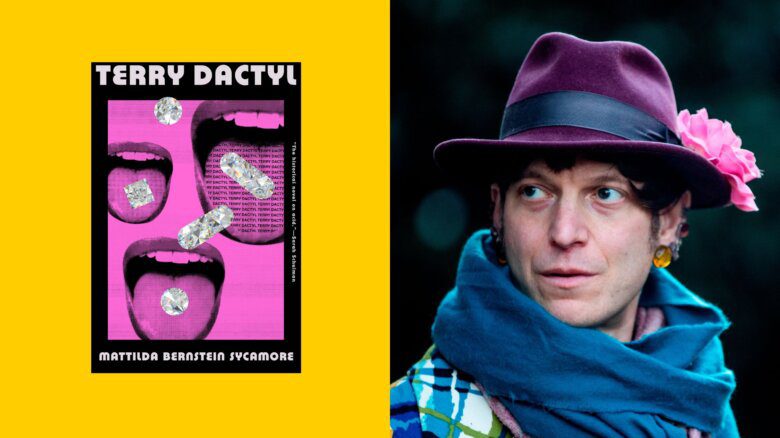Generally, when we hand over money to see a gay baseball player in various shower and locker-room scenes, it’s at our local video store.
How refreshing, then, to view a far more decorous depiction of gaydom’s favourite pastime (baseball, not porn, you pervs) while still enjoying a judicious amount of nudity and locker-room bonhomie in CanStage’s production of Take Me Out, opening Thu, Jan 20.
Richard Greenberg’s Broadway smash tells the story of Darren Lemming (played by Thom Allison), a cocky young star at the top of his game, who decides to reveal his sexual orientation to both his unsuspecting team and the world-at-large during a press conference. Most of Darren’s compadres initially seem fairly cool with his disclosure, but, as we all know, everything can change in even the most liberal locker room.
Sure, his teammates still change and shower around him, but it becomes obvious that innocent het-boy pleasures such as towel snapping and a good-natured soapy wrestle are now strictly verboten.
All hell breaks loose when newbie pitcher Shane Mungitt (Mike Shara) spouts some good ol’ fashioned hillbilly homophobia in an interview, and Lemming is confronted with the ugly undercurrent of bigotry both within the clubhouse and in the world outside.
“It felt like team sport was the last bastion of homophobia,” says writer Greenberg. “The only way someone could stay in the game and be out is if he were already an established superstar. And you’ll notice nobody’s come out yet.”
As his passion for the sport grew, so did his interest in the cultural relevance and impact of the game. “All I really wanted to do was write about baseball,” says Greenberg, “but the more I knew about baseball, the play grew larger. It became more and more evident that [it’s] this thing where classes meet, races meet.”
Inspired by retiring San Diego Padres outfielder Billy Bean’s coming out in 1999, and a bigoted interview given by former Atlanta Braves pitcher John Rocker in Sports Illustrated, Greenberg found the protagonist and antagonist necessary for his plot, and began his personal homage to America’s favourite pastime (again, not porn).
He deliberately blurs the moral lines between the two characters, wisely avoiding the saintly homo shtick in his treatment of Darren, and in turn, steering away from an outright demonization of Shane.
“[Shane] is a little crazy,” says Greenberg. “He’s out of his depth. He’s somebody who shouldn’t have ever been asked to talk in public.” His rant includes some pretty vitriolic antigay slurs, but in this stark depiction, Greenberg decided to take the full frontal approach with Shane’s words.
“It’s wonderful to write characters that really vent their spleen,” he says, chuckling. “We tiptoe around people’s feelings, so when you get to write someone sheerly, indulgently horrid, it’s real horrid.”
Director Morris Panych (Overcoat, Vigil) enjoys this moral blur and exploits it happily in his treatment of the script.
“I liked that we’re conflicted about the characters,” he says. “The bad guys aren’t totally bad and the good guys aren’t totally good.”
He has taken pains to illustrate an in-depth view of bigoted behaviour. “I’ve tried very hard to make the audience feel sorry for him, because I want the audience to be conflicted about him,” he says. “I want it to be a fine line in every sense. I don’t want people to think this is right or this is wrong. It’s more complicated.
“If you make the character one dimensional, then people can disregard it as unrealistic. Homophobia and hate mongering come out of people you may meet on the street and actually like. That’s what’s sort of tragic and complicated about it.”
The script exploits this tangled mess of amiability and prejudice beautifully, showing us that though Shane spouts some pretty horrible ideas, he is also very much a product of his education and environment.
“There’s a certain language that he’s just inherited,” Greenberg says. “Does he know what he really feels?”
Take Me Out won critical acclaim, put bums in seats and landed Greenberg a Tony Award in 2003, which he calmly accepted with the aid of an anti-anxiety drug. “I didn’t realize that I’d won for about three months,” says Greenberg. “I was lying on my bed in the autumn and I said, ‘Shit, I won a Tony.'”
“It was a really good play about homosexuality and homophobia,” says Panych, “and it was one of the few fucking plays that the gay character didn’t have AIDS. He’s a very positive but realistic role model.”
Thom Allison (Outrageous) found the character a natural fit when he auditioned for the role. “It’s the first time I’ve ever read a play or a script and thought: ‘I know this guy. I see parts of myself in him,'” he says.
“What I really love about Darren is that he’s this rarity: a black man who’s never had to suffer, and something about that has left Darren an optimist.
“There’s a sense of otherworldly hopefulness… it’s what we hope the world could be. Darren is representative of what we hope any open-minded human being’s attitude would be. His sexuality is no big deal, just another aspect of who he is.
“The whole play ends up being not so much about his homosexuality – that’s just the catalyst. Darren is closed, and it’s about him coming out of his solitariness as this icon who is, in fact, very solitary and alone. That ends up being the real issue.”
Nonsports types are allowed to understand the peculiar passions of baseball fans through the play’s other gay character, the accountant Mason Marzac, Darren’s money manager (David Storch), who waxes eloquent on the virtues of the sport.
With a story so firmly rooted in the world of baseball, set design becomes a major factor in successfully drawing audiences into Take Me Out. Designer Ken MacDonald joins longtime collaborator (and partner) Panych to craft a set (that Allison calls “perfection”) with a striking backdrop of stylized lockers and a view to the field beyond.
“This show takes place in a number of locations,” says MacDonald, “but they pop back and forth very quickly, so we chose to basically set this in the clubhouse.”
MacDonald is also designing the wardrobe for Take Me Out, showing his characteristic attention to detail in getting an authentic look for both on and off the field.
“I went to the Blue Jays clubhouse at Skydome, and did a huge amount of research. There’s a certain protocol in the clubhouse about what people wear – either a suit and jacket or a really nice tracksuit. You have to look respectable.
“You have to remember that some are young guys that have no taste, but all of a sudden they have money. I had fun,” he says, laughing, “and I know every single garment in Banana Republic.”
(MacDonald and Panych have been busy boys lately, juggling Take Me Out with a Connecticut production of The Overcoat, while preparing for a Vancouver run in February of Panych’s new play, Dishwashers.)
With most of the Take Me Out’s action taking place in locker and shower areas, there is an inevitable (and generous) amount of nudity happening onstage. Greenberg’s scenes illustrate, on a very basic level, the sort of changes happening to the team.
The transition from lighthearted nakedness to guarded suspicion serves as a blatant and poignant sign of the loss of intimacy suffered by both Darren and his teammates. Apparently slapping your friend’s naked backside is gay only if he is.
“It’s just guys standing around in the shower talking to each other,” says Allison. “There’s nothing sexual about it. It’s a real scene. You really do forget about it, but it gets all the press.
“Hopefully they’ll come for the cock and stay for the story.”
A strong cast also goes a long way in garnering media attention, and it doesn’t hurt to boast actors like Storch (Amadeus), Matthew MacFadzean (Shopping And Fucking), Randy Hughson (The Lonesome West) and Jovanni Sy (Twelfth Night). Harry Crane, Darrell Dennis and Aaron Franks join Dion Johnstone and Any Velasquez (Goodnight Desdemona, Good Morning Juliet) in filling out a solid roster.
Audiences, production teams and critics seem to agree that Take Me Out is, most of all, a play about baseball and the people who love the sport.
For Greenberg, it’s about finding a way to express those feelings when he first became enraptured with the game, and discovering pieces of his own identity and community on the playing field.
“Even though I enjoy writing very, very much, I don’t usually write out of an urge to celebrate,” he says, “but this one was a strong sense of celebration for me.
“I remember standing in previews for the first time and watching it, and feeling so lucky that I’d been able to write about this, and that it had gotten that far. Because something struck me so forcefully and so belatedly then: I felt very happy in my job.”

 Why you can trust Xtra
Why you can trust Xtra


